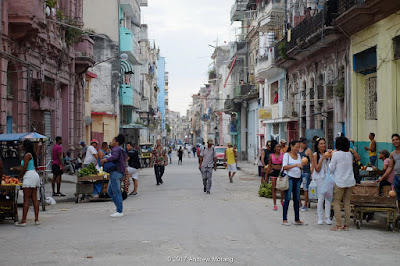 |
| Detroit Publishing Co., Publisher. [Hotel Pasaje and Prado, Havana, Cuba]. Cuba Havana, None. [Between 1900 and 1915] Photograph. Retrieved from the Library of Congress, https://www.loc.gov/item/det1994023933/PP/. (Accessed March 19, 2017.) |
The Paseo del Prado, also known as the Paseo de Martí, is a boulevard with a tree-lined marble promenade running along the center. The Paseo divides Habana Viejo from Centro, and runs from the seaside Malecón south to the Capitolio. In the afternoon, the Paseo is the place to be seen, and a broad cross-section of Havana society congregates under the trees to walk, talk, sing, play music, skateboard, eat and generally foregather. According to
Wikipedia, the Paseo was laid out in 1772. In 1925, Jean-Claude Nicolas Forestier, a French landscape architect, redesigned the it, lining it with trees and marble benches (Forestier? What a splendid name for a landscape architect.)
 |
| The Prado, circa 1921-1939, E.C. Kropp Co., Milwaukee, Wisconsin. In the Public Domain, Courtesy of Special Collections, University of Houston Libraries. |
 |
| The chess champions, Paseo del Prado (Tri-X film) |
As for fading architecture, you see some splendid examples along the Prado. Moorish architecture? In the Caribbean?
 |
| Neptuno view west. |
 |
| Another view of Neptuno looking west |
 |
| San Miguel |
 |
| A street market on San Miguel. I assume this is an example of the small-scale capitalism that is now allowed. Some of the goods were for the tourist trade. |
The side streets looking west into Habana Centro are pretty interesting. Really, you could spend an entire day along the Prado watching the people and exploring the side streets.
I took these photographs with a Fuji X-E1 digital camera, most with a Leica 50mm f/2.0 Summicron lens.
For a view inside some of these fading mansions, look at this
January 2017 article titled "Inside Old Havana" in American Airlines' magazine,
American Way. A German photographer, Bernhard Hartmann, met families who lived in these old houses and gained permission to photograph inside.



